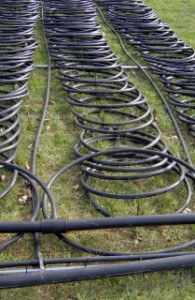 Geothermal or earth energy systems and ground-source heat pumps have been generating plenty of buzz in Manitoba in recent years for their ability to provide reliable, environmentally-friendly heating and cooling for homes. And they do this while using a readily available resource – energy from the earth below us.
Geothermal or earth energy systems and ground-source heat pumps have been generating plenty of buzz in Manitoba in recent years for their ability to provide reliable, environmentally-friendly heating and cooling for homes. And they do this while using a readily available resource – energy from the earth below us.
On this page, we explore the following topics related to geothermal heating in Manitoba:
Click a link in the list above to jump to that topic on this page.
Manitoba has become a national leader in geothermal technology with more than a quarter of all installations in Canada happening in Manitoba. (1)
Geothermal systems draw heat or cold from the earth using a series of pipes placed underground. The temperature in the ground below the frost line is fairly constant – cooler than outside air in summer and warmer in winter. In winter, geothermal systems distribute the heat through the house, while in summer they work in reverse, circulating cooler air from the earth through the house, and returning the heat to the ground. They may also provide water heating.
Using geothermal heating and cooling could reduce annual heating costs by 50-70 percent.
- The average single-family residence would see annual heating costs of approximately $449/year with geothermal, compared to $991/year for a high efficiency gas furnace or $1455 for a conventional gas furnace. (3)
- Other than the electricity to power the system, it requires no other energy source.
- For the average house, this could mean a five tonne per year cut in greenhouse gas emissions. (4)
Geothermal system components
This video shows the basics of a geothermal.
(NOTE: This is a commercial video from the US. CCC does not recommend or endorse any company, product, or service)
Geothermal systems have three components:
- ground loop
- heat pump
- distribution system
Ground Loop
The ground loop extracts the energy from the earth, from the bottom of lakes or ponds, or from subterranean aquifers.
The loop may either be closed or open:
- Closed loop circulates a fluid mixture through underground pipes
- Open loop circulates well or surface water
The loops may be laid horizontally or vertically:
- Horizontal loop systems require more space.
- Vertical loop systems are more appropriate for smaller city lots but require deeper holes. For instance, four boreholes drilled into an area of 100 ft² (9 m²) may be sufficient for a 1600 ft² (150 m²) house. (2)
Heat Pump
Inside the house, the heat pump transfers heat between the distribution system and the ground or ground-water loops.
Distribution System
The air is then distributed through the house’s ductwork (in a forced air system) or via a hydronic (hot water space heating) system.
New home construction
Installing a geothermal system in a new home makes more sense than retrofitting it later for these reasons:
- The installation cost could become part of the overall financing for the house.
- The savings on the heating bills would start immediately.
- Access to the lot should be easier, with fewer concerns about harming landscaping, while other requirements (electrical service etc) could be built in immediately with less fuss.
Existing home retrofit
Thousands of Manitobans have installed geothermal into existing homes. To properly install geothermal into an existing home, there are a number of challenges. A certified Manitoba Geothermal Energy Alliance (MGEA) contractor can take care of these for you:
- Access to the site with heavy equipment needed for digging may be difficult. Some contractors specialize in small lot installation with minimal disturbance to the yard.
- Your home’s electrical service may need to be upgraded, especially if you’re replacing a fossil fuel furnace.
- Because more air needs to be moved through the house, ductwork may need to be upgraded, although this is often not required.
- Existing heating and cooling equipment will need to be removed carefully and services cancelled. (5)
The Government of Manitoba suggests that often the best time to install geothermal into an existing house is when replacing the heating and/or cooling system.
Your certified MGEA installer can advise you of the options available to provide a cost-effective and optimized geothermal system for your home.
Financial assistance
Geothermal systems usually require a larger up-front investment than most conventional heating and cooling systems. However, in return this investment can reduce your annual heating costs by up to 70 per cent if for example you are using oil or electric heat.
There are some financial incentives and assistance available to help you make the investment in geothermal:
- Incentives are offered through the Manitoba Government’s Geothermal Energy Incentive Program
- Manitoba Hydro offers residential loans through its Earth Power Loans program.




